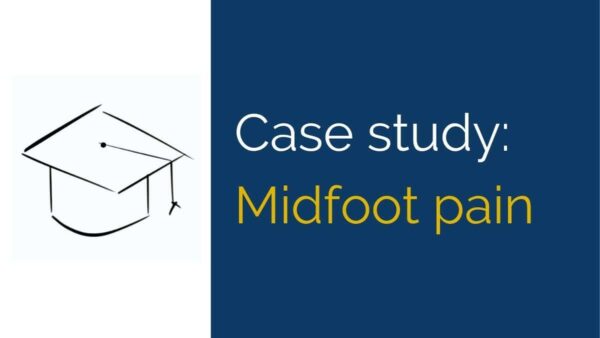Background – Midfoot pain
This case study examines a sudden onset of midfoot pain in a female teenager with difficulty returning to full weight bearing. There is added complexity with apprehensive behaviours and other factors.
Minimum level
New graduate Physiotherapist
History
Kirsten is a 16 year old who presents with a 4 week history of medial midfoot pain in her Left foot.
This pain commenced during skipping with a jump rope during a fitness session. There was a sharp pain on landing after 5 minutes of skipping, followed by a worsening residual ache and inability to walk without significant pain.
What further questions would you ask to clarify this information?
List potential diagnoses for this injury.
Provide some possible mechanisms of injury for each pathology.
The midfoot pain continued overnight despite remaining non-weight bearing on crutches.
Is this overnight pain a concern? Justify your answer.
After 4 days, the pain began to ease but became very painful with any attempt to return to full weight bearing (FWB).
After 2 weeks of intermittent use of the crutches, Kirsten attempted to return to FWB but found it caused frequent sharp pains.
Which diagnoses become more probable with this information?
Which diagnoses are less likely to present with this pattern of symptoms?
Kirsten regularly trained in ballet and jazz dancing before COVID restrictions forced her dance studio to temporarily close around 12 weeks ago.
Which implications might this information have on your diagnostic reasoning?
Kirsten has no past history of injury however she has an older sister with a history of multiple foot and tibial stress fractures.
What clarifying questions would you ask regarding this family history?
(Further reading on family history of stress fractures here.)
Physical Examination
At the start of the physical examination, Kirsten appeared very apprehensive about aggravating the midfoot pain.
Explain how you would adapt your physical examination based on this observation.
On standing, almost all weight bearing was applied to the unaffected side. There was no pain reported in this position.
This shift in loading continued during assessment of squat and double leg heel raises. These were also reported to be pain-free.
How would you interpret the outcome of standing, squatting and heel raise testing?
Range of motion is assessed with passive movements in long sitting.
There is restrictions noted at the ankle with mild reductions in dorsiflexion and eversion.
Midfoot mobility also appears reduced compared to the Right foot, particularly through medial midfoot joints.
Do you feel that the restricted range is causative or a result of abnormal loading patterns over the previous 4 weeks? Justify your response.
On palpation, there is tenderness to touch at the Naviculo-cuneiform and 1st TMT joints as well as sensitivity medially over the Navicular and medial cuneiform.
You trial some midfoot mobilisations and note that the mobility of the medial midfoot joints seems to improve after 20 seconds of mobilisations. There is also less midfoot pain reported on palpation over the Naviculo-cuneiform and 1st TMT joints.
Discuss the possible implications of this finding.
Comment on the limitations of the reassessment measures.
Muscle strength testing (IMT) appears normal.
At this stage, you notice that Kirsten appears to be increasingly apprehensive and upset so you decide to cease the physical examination.
Given the limited physical examination above, are there any further questions you’d like to ask Kirsten to assist with your diagnosis?
Diagnosis
Make a provisional diagnosis and justify it based on the above information.
Management planning
Plan your management approach for the next two weeks.
Justify each aspect of the plan and state your expected outcome from the intervention.

